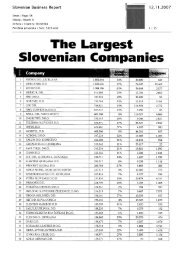The Group KD Group and KD Group dd
The Group KD Group and KD Group dd
The Group KD Group and KD Group dd
Create successful ePaper yourself
Turn your PDF publications into a flip-book with our unique Google optimized e-Paper software.
<strong>The</strong> <strong>Group</strong> <strong>KD</strong> <strong>Group</strong> Annual Report 2009<br />
Notes to Consolidated Financial Statements as at <strong>and</strong> for the year ended 31 December 2009<br />
5.1.4. Long-term life insurance – assumptions, changes in assumptions <strong>and</strong> sensitivity<br />
a.) Procedure of establishing assumptions<br />
Liabilities from life insurance contracts with DPF were calculated using assumptions on future mortality from statistical tables.<br />
<strong>The</strong> portfolio of insurance contracts was too small in the past, so for the purpose of estimating mortality the following statistical<br />
tables are used:<br />
- for life insurance contracts with DPF, Slovenian morality tables from 1992 were used;<br />
- for annuity products, German mortality tables from 1987 were used<br />
- cancellations,<br />
- returns on investments (rate 2.6%-4%).<br />
<strong>The</strong>se assumptions are set at the time of concluding the contract <strong>and</strong> remain the same throughout the term of insurance, or<br />
safer assumptions are used in the calculation of liability to provide for the possibility of unfavourable deviation from<br />
expectations. An a<strong>dd</strong>itional adjustment is applied to these assumptions to account for risk <strong>and</strong> uncertainty.<br />
New estimates are made for each subsequent financial year for the purpose of checking the adequacy of liabilities determined<br />
in this manner. If it is determined that the established liabilities are adequate, assumptions remain unchanged. If the<br />
established liabilities prove to be inadequate, assumptions are revised to reflect new expectations. Consequently, the<br />
provisions are measured according to appropriate level.<br />
<strong>The</strong> assumptions used for insurance contracts described hereunder are as follows:<br />
• mortality<br />
Depending on the type of contract, the appropriate mortality table is chosen <strong>and</strong> adjusted to reflect actual mortality<br />
of the insurance portfolio in past years <strong>and</strong> the current period.<br />
• cancellations<br />
An analysis of the <strong>Group</strong>’s experience of the past three years is carried out by application of statistical methods, <strong>and</strong><br />
the appropriate cancellation percentage is determined. Cancellation percentages vary by type of product <strong>and</strong> term<br />
of the insurance period. <strong>The</strong> analysis is carried out in order to determine the best estimate of the policyholders’<br />
behaviour.<br />
• returns on investments<br />
<strong>The</strong> <strong>Group</strong> established assumptions for returns on investments by taking into account present returns on<br />
government-issued securities <strong>and</strong> other financial instruments on the market. In a<strong>dd</strong>ition to this, the structure of<br />
assets which are used to cover liabilities stemming from life insurance contracts (long-term business fund) is taken<br />
into consideration by determining weighted average returns.<br />
• costs<br />
Future costs are determined on the basis of current costs. <strong>The</strong> future inflation assumption was also applied.<br />
b.) Changes in assumptions<br />
In 2009 the <strong>Group</strong> made no changes in the assumptions used in the calculation of insurance contracts.<br />
118







